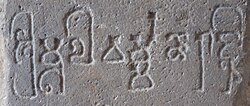
Sri Mulavarman Nala Deva (spelled Mulawarman in Indonesian), was the king of the Kutai Martadipura Kingdom located in eastern Borneo around the year 400 CE. What little is known of him comes from the seven Yupa inscriptions found at a sanctuary in Kutai, East Kalimantan. [3] He is known to have been generous to brahmins through the giving of gifts including thousands of cattle and large amounts of gold. [4]




